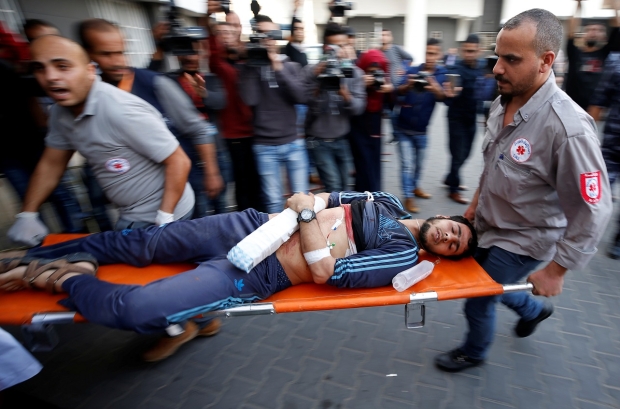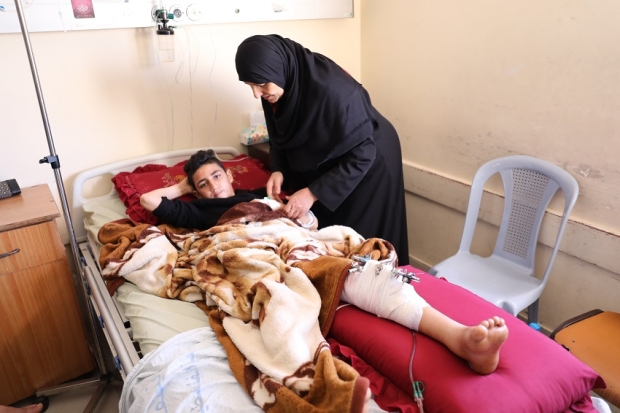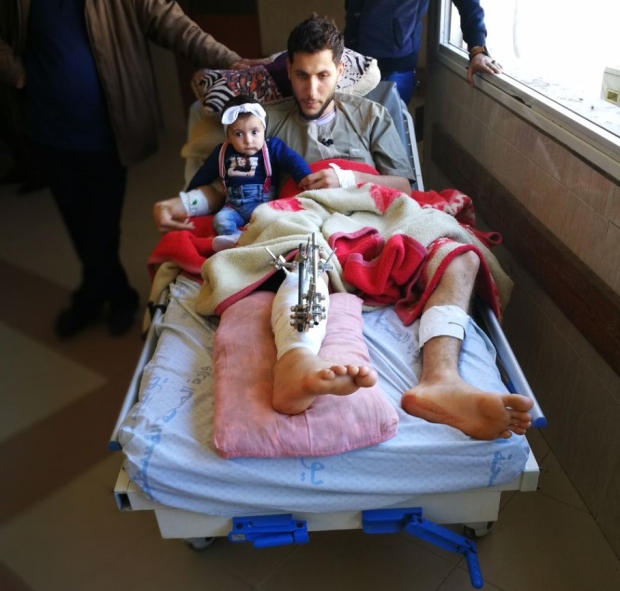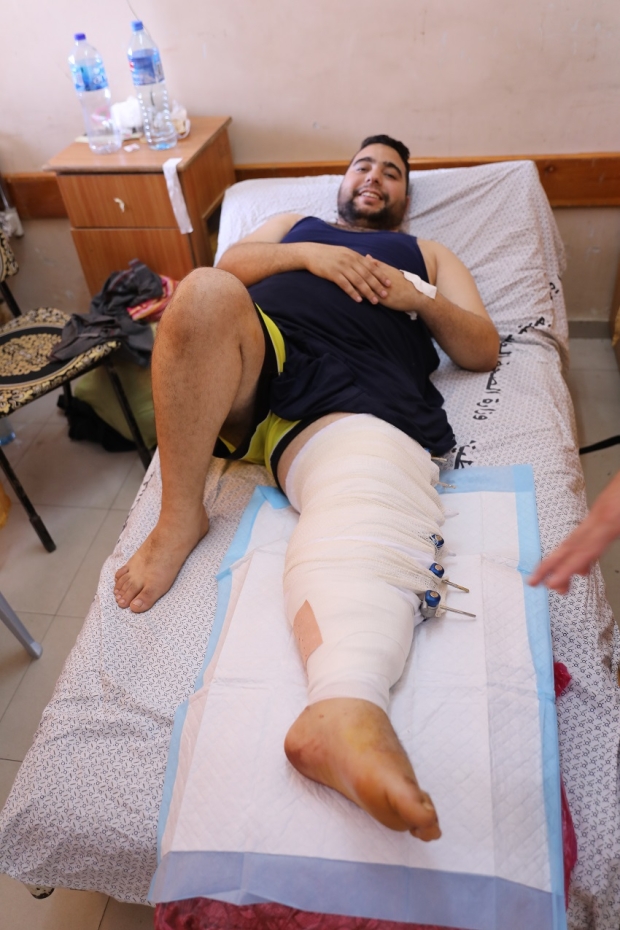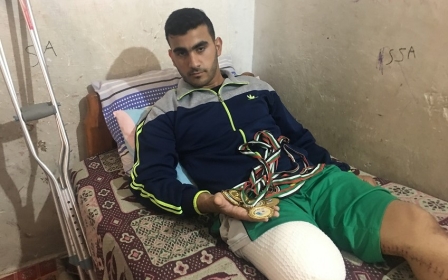Great March injuries pushing Gaza's hospitals to brink of collapse

GAZA STRIP - The scenes at the emergency entrances at Gaza's hospitals are not for the faint-hearted. They have been especially dreadful on Fridays when the number of injured protesters participating in the Great March Return intensifies at the Gaza-Israeli border.
Wailing ambulances rush into hospital emergency gates and bloody casualties who were given quick first aid treatment are pulled out of the vehicles, each person hoping to be saved and not fall victim to Gaza's poorly equipped hospitals.
I feel like I am stranded on the beach, and there is this huge wave in front of me. I can do nothing but swim
- Mohammed Aslan, nurse
“When injuries start coming in, I feel like I am stranded on the beach, and there is this huge wave in front of me. I can do nothing but swim,” Aslan described.
The injured are usually scattered around the 31 hospitals in the strip that are either run by the government, or by non-governmental organisations (NGOs).
Since the Great Return March started on 30 March, calling for Palestinian refugees' right to return to their former homes now inside Israel, more than 7,000 Palestinians have been injured and at least 45 have been killed. The rapid increase in the number of injuries is a conundrum for hospitals running on an insufficient number of staff, drugs and operating rooms.
According to Ashraf Qedra, the Ministry of Health’s spokesperson, Israeli forces follow a shoot-to-kill or leave with a disability order, which only adds salt to injury considering the state of Gaza’s healthcare system.
The Israeli army says its forces only open fire on "instigators" or to stop protestors approaching the fence separating Gaza from Israel.
However, rights groups have said that Israel is carrying out a policy of deliberately targeting protesters with live fire and using "excessive and lethal force". As a result, the death and injury tolls are expected to rise, making an already dire situation at hospitals even worse.
Rationing painkillers
According to the Ministry of Health in Gaza, the majority of injuries being attended to are in the lower limbs, and while most of the wounds are considered serious, hospitals run on a case-by-case basis.
Life-threatening injuries are prioritised, while others are given over-the-counter painkillers to wait out the pain until it is their turn for treatment, which sometimes might be more than 24 hours.
“We deal with the patients who have to wait for their operations with painkillers until we go through the first hours of the injuries. Priority is for the life-saving operations. Then we can work with the rest,” Aslan said.
I had to wait for 27 hours in the corridors of the hospital before I had my operation
- Mohammed al-Masawabi, injured protetser
He is now stable, but he will not be able to use his leg until the external fixator is removed in one month’s time. The boy cannot bear to look at the foreign object sticking out of his leg, so his family covered his injured limb with a blanket.
In order to get a good night's rest, he saves his share of painkillers for nighttime.
“The only painkiller we have at the hospital is ibuprofen. This is the only painkiller I can give to the patients. I have to ration what I have among patients,” Aslan stated.
Wahdan says he took part in the protests with his friends. His mother told Middle East Eye that she had never expected to get a phone call informing her that her son was injured and in the hospital.
“The protests were meant to be peaceful. We did not expect Israeli soldiers to open fire on protesters. This is why we allowed him to participate,” Wahdan’s mother added.
Long wait
In the corridors of al-Shifa, Gaza’s largest hospital, injured protesters can be heard moaning from severe pain as they lie on rusty stretchers awaiting surgery. Some of the injured are accompanied by weeping family members, while others are forced to wait alone.
The fear is palpable, as they look for their loved ones amid the many injured. The busy hospital does not have a moment to spare to contact the families of the wounded. Nurses and doctors are rushing around helping save lives, administering first aid, and distributing painkillers until the operating rooms are finally empty and exhausted medical personnel can resume a normal pace.
Israeli troops opened fire at him and a group of protesters as they carried an injured protester towards the ambulances near the Gaza-Israeli security fence. Masawabi needed immediate care and a medical transfer to the West Bank to treat his injury. However, Israeli forces denied him entry to the West Bank for treatment.
The Israeli military said that apart from “exceptional humanitarian cases,” medical treatment would not be provided to Palestinians who took part in the protests.
The only painkiller we have at the hospital is ibuprofen
- Bashar Wahdan, 12-year-old child
“It was decided that any request for medical treatment by a terrorist or a rioter who took part in violent events would be denied,” an army statement said. “Foreign residents have no vested right to enter Israeli territory, including Palestinians living in the Gaza Strip.”
Masawabi was transferred to al-Shifa hospital. Due to the influx of patients in comparison to the small number of rooms available on Fridays, Masawabi, like many others, had to stay on a hospital stretcher in a corridor of the unit. His father brought him a clean blanket and Masawabi's little baby girl kept him company on his stretcher.
“I had to wait for 27 hours in the corridors of the hospital before I had my operation,” he said. After the long wait, he was finally admitted to surgery.
“By the time I underwent my surgery, I had lost a lot of blood,” al-Masawabi added. Fortunately, his leg was not amputated, but he will not be able to walk until his months-long recovery is complete.
Doctors prematurely discharge most patients after a few days to free up more space before they are faced with a new wave of casualties on Fridays.
“There are patients we discharge after two or three days of their injuries. If this patient were outside Gaza, he would stay at least for a month in the hospital,” Aslan said.
Because the patients are not getting sufficient time to heal and receive adequate medical care, this can result in severe infections, which forces many patients to return to the hospital and possibly face amputation, according to Aslan.
“We have to deal with at least 1,000 serious limb injuries which need medical intervention while we have very limited resources,” said Mahmoud Matar, an orthopaedic surgeon.
Shortage in staff and drugs
The scenes do not look any better at al-Shifa hospital's intensive care unit. The head of the ICU, Gihad al-Geady, said that there are only nine beds available in the ICU, but the number of patients needing to be admitted is much higher.
“We are also short on the number of ICU nurses and physicians. The overstretched doctors have to work for longer shifts and are sometimes forced to handle multiple cases at once,” he added.
We at least have to deal with 1,000 serious limb injuries which need medical intervention while we have very limited resources
- Mahmoud Matar, orthopaedic surgeon
The Great Return March started on 30 March to coincide with Land Day. The series of peaceful rallies are scheduled to continue until 15 May, which is the day that Palestinians commemorate the Nakba (the catastrophe). More than 750,000 Palestinians were forcibly displaced from their towns and villages in the Palestinian territories in the wake of Israel's establishment in May 1948.
In 1948, the right of return was granted to Palestinian refugees by UN General Assembly Resolution 194. Later in 1967, the UN Security Council passed Resolution 237, which demands that Israel facilitate the return of refugees to their lands.
Health sector on verge of collapse
After a decade of an Israeli-imposed blockade and the aftermath of three deadly wars, the last of which was in 2014, hospitals in Gaza have been suffering a severe shortage of medical supplies and consumables.
The World Health Organisation (WHO) reported in February that 42 percent of drugs were totally depleted while 23 percent of needed disposables are at zero stock. Since the Great Return March began, Gaza's Ministry of Health has been calling on medical and international organisations to intervene in the critical situation and provide hospitals with needed medical supplies.
Political divisions have also played a role in the deterioration of Gaza's health system. According to the WHO, more than 6,000 doctors and medical personnel have not received salaries since July 2014. Moreover, the PA continues to impose a 30 percent wage cut on 60,000 civil servants, which has been implemented since April 2017.
Yet Palestinians in Gaza say they refuse to give up, and will always stand tall - even if they are on crutches.
New MEE newsletter: Jerusalem Dispatch
Sign up to get the latest insights and analysis on Israel-Palestine, alongside Turkey Unpacked and other MEE newsletters
Middle East Eye delivers independent and unrivalled coverage and analysis of the Middle East, North Africa and beyond. To learn more about republishing this content and the associated fees, please fill out this form. More about MEE can be found here.


